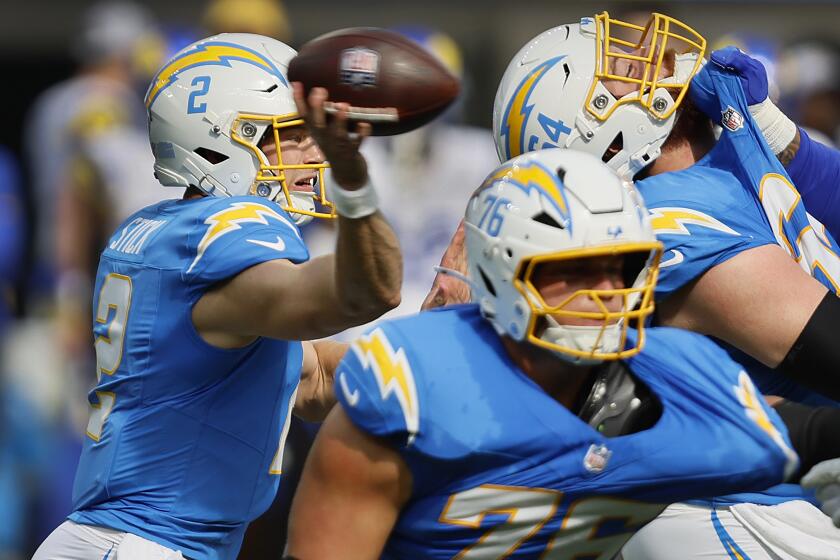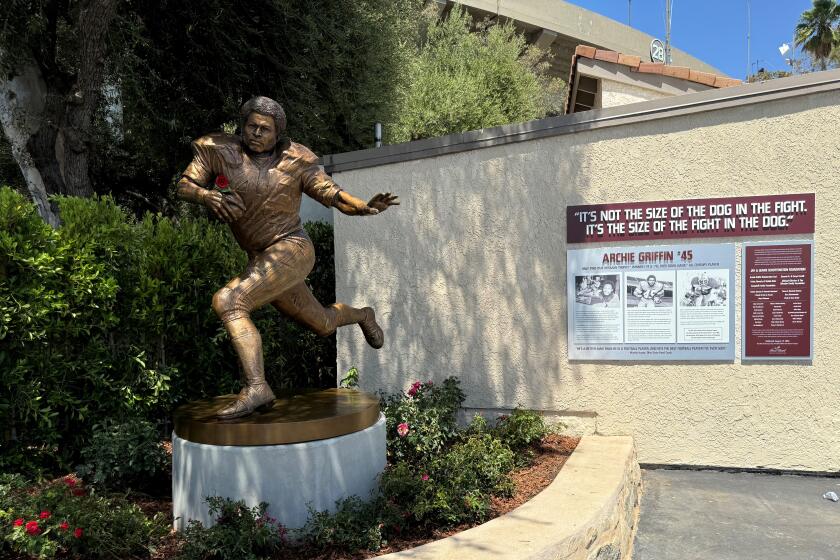For Have-Not Fullerton, Having Its Own Stadium Is Vital : College football: Titans’ facility nears groundbreaking, as sport’s rich get richer.
After years of planning, millions of dollars and nearly as many prayer candles lit by Coach Gene Murphy, Cal State Fullerton’s on-campus football stadium is finally scheduled to open in the fall of 1992.
But will the Titans live to enjoy the comforts of a home stadium for long? Or will the City of Fullerton wind up with the finest soccer facility in Orange County?
“I would hate to think that multipurpose stadium won’t be used for football,” Murphy said of the Titan Sports Complex, scheduled for construction beginning this fall. “But that’s a possibility.”
Fullerton has survived for years in Division I-A despite having no on-campus stadium, meager facilities, a tiny budget and minimal fan support. The Titans ranked 105th out of 106 Division I-A teams in home attendance last season. No. 106 was Cal State Long Beach.
But vast changes are sweeping college football, and it’s doubtful that Fullerton will get swept along in them. More likely, the Titans will be swept aside, or, possibly, under the rug.
The forming of what athletic directors are calling “super conferences”--the aligning of major football-playing schools for television revenue purposes--could threaten the Big West Conference’s Division I-A status.
Perennial Big West power Fresno State, the only conference school that annually fulfills the NCAA’s Division I-A attendance requirements, would be attractive to a super conference. Other possibilities might include San Jose State, with its strong program and large television market, and Nevada Las Vegas with its strong basketball program. If those three schools leave, as some have speculated, the Big West could find itself scrambling for its Division I-A life.
Fullerton’s Division I-A future could depend on its ability to align itself with other Division I-A teams that don’t become part of the super conference structure.
And much of its football future could depend on the financial and spectator impact of the sports complex and the mood of the school’s faculty, which has questioned the viability of the football program.
“Nobody has a crystal ball and there’s uncertainty as to what’s going to happen nationally,” said Ed Carroll, Fullerton’s athletic director. “I’m optimistic that these changes will work to our benefit, but that remains to be seen.”
Notre Dame negotiated its own TV deal with NBC, Penn State is joining the Big Ten Conference, Arkansas is leaving the Southwest Conference for the Southeast Conference, Texas and Texas A&M; pondered joining the Pac-Ten, and many believe Fresno State, and possibly San Jose State and UNLV, will look for greener pastures.
Many athletic directors doubt that the College Football Assn., a consortium of 64 major football-playing schools whose primary purpose is to negotiate television contracts, will exist beyond its present contract, which expires in 1995. Instead, super conferences will strike their own TV deals.
“Anyone who isn’t in the upper echelon of our conference from the standpoint of TV attractability and home attendance is a little nervous about what’s happening across the country,” said Jim Haney, Big West Commissioner.
The upper echelon of Big West football consists of one team, Fresno State.
In order to remain a Division I-A conference, the NCAA states that 60% of the conference’s schools (five in the Big West) must either:
--Have a 30,000-seat stadium and average 17,000 fans at home.
--Average 20,000 fans for all games.
--Meet these criteria once every four seasons.
If you take Fresno State, which ranked 56th among Division I-A schools in home attendance with a 34,100 average in 1989, out of the Big West the conference might have trouble meeting the criteria.
“The problem for schools like Fullerton and Long Beach is they’re not meeting Division I-A criteria on their own, so they’re dependent on the conference,” Haney said. “Other than Fresno, everyone in our conference is experiencing hard times.”
In the NCAA home-attendance rankings, Big West conference schools hold down the last four of 106 spots: Cal State Long Beach (2,650), Fullerton (3,741), University of the Pacific (5,540) and San Jose State (8,118).
New Mexico State ranked 100th with an average of 11,304, Utah State was 94th at 15,553 and Nevada Las Vegas was 92nd at 17,100.
Some have questioned whether Fullerton’s place is in Division I-A football. The Titans certainly aren’t a model I-A program.
Some say Fullerton should discontinue the sport because of bottom-of-the-barrel home attendance figures and the high cost of the program compared to its minimal revenue.
“Football has cost us millions of dollars that could have been used in academic programs,” said Dr. Robert Feldman, a Fullerton professor and member of the Academic Senate.
Some also criticize a scheduling philosophy that has Fullerton playing road games it has virtually no chance of winning--Murphy calls them “body-bag games”--in exchange for large guarantee checks that help sustain the program.
They lament that Fullerton has dropped four athletic teams (men’s and women’s golf, men’s water polo and men’s tennis) in the past 10 years while football trudges on. Last spring, fencing and men’s gymnastics were on the chopping block, but both received a last-minute stay. The critics also are disgusted by recent off-the-field troubles--one Titan football player was shot and two others arrested during a bar-room brawl this spring, and an El Toro Marine died from injuries incurred in a fight with two Titan football players in April, 1988. Charges were not filed against the players.
But there is also a large football faction, those who point to Murphy’s 54-60-1 record in 10 seasons and marvel at how much he has accomplished with so little.
The Titans allocate the equivalent of 60 scholarships per year--35 fewer than the NCAA’s Division I-A limit. Despite their lack of an on-campus stadium and fan support, they have placed first or second in the Big West six of the past seven seasons.
Several Fullerton players have gone on to the NFL and several Titan assistants have moved up to the professional ranks or to bigger Division I programs.
And many think the Titan Sports Complex, which will include a 10,000-seat, multipurpose stadium that can expand to 30,000 if needed, will lead to football prosperity.
As it has so often, the football debate raged on in the Fullerton Academic Senate this spring, with some professors wanting to give the sport the boot. As it has every time, football won and will be around at least another season.
But can Titan football continue to exist as it has in Division I-A, and will it ever develop a substantial following?
Athletic Director Carroll doesn’t have any grand illusions of Fullerton becoming a national power in football or competing with USC and UCLA for Southern California’s college sports-entertainment dollar. He doesn’t even see football turning a profit in the foreseeable future.
But he does believe that there’s a niche for Fullerton in Division I-A and in Orange County. And the key to developing that niche is the on-campus stadium, which Carroll says will allow the school to change its scheduling philosophy.
The Titans, who have averaged four home games and eight road games per season the last 12 years, will play more at home. And they won’t be tempted to change home games to away games to increase profits, as they did with the Fresno State and San Jose State games this season.
Carroll also hopes to schedule one or two attractive nonconference opponents at home each season. The Titans already have lined up Mississippi State for their 1992 season opener, and Army, Temple and Texas Tech have agreed to play at Fullerton in future years.
Carroll also sees the stadium having a positive impact on attendance. A seat-option plan, under which prime-location season tickets are tied into donations to the program, should increase fund-raising. The stadium also should help recruiting.
Carroll hopes increased revenue from ticket sales and fund-raisers will eliminate the need for road games against schools such as Louisiana State, Auburn and Florida and allow the Titans to play a more realistic schedule.
If the Titans can field competitive teams and play quality nonconference opponents and conference rivals at home, Carroll sees no reason they shouldn’t attract good-sized crowds.
And if they continue to challenge for the conference championship and win an occasional title, Carroll believes the program has the potential to gain an occasional Top-20 ranking, as it did in 1984.
“Some say we shouldn’t play football because we don’t make money on the sport, that not enough people come to games, that no one cares--all different things,” Carroll said. “I think all those can be overcome in the next five years, and I’m looking forward to that happening and being able to tell the detractors they were wrong.”
Carroll envisions a Titan Sports Complex awash in blue and orange; others look at the football program and see red.
“Our team lives a bare-bones existence because it participates in an area we can’t afford to be participating in,” Fullerton Professor Feldman said. “What we wind up doing every year is having this debate. Which program will we have to throw overboard this year?”
Feldman likens the football program to a “great big sponge,” absorbing all of the resources of the athletic department. Carroll says the description isn’t fair.
“Football generates about one-third of the athletic department’s revenue and spends about that much,” Carroll said.
However, more than half the revenue listed as “generated” in the football budget is actually state funds allocated to the athletic department. In 1988-89, for example, football received $647,018 in state funds and generated $557,538 for a total of $1,204,556, which nearly covered expenses of $1,211,318.
With state money and a pinch-the-pennies program, the school has balanced its football budget most years. Without state money, there wouldn’t be a football program.
Some educators are tired of seeing so much state money--about $5 million in the past 10 years--going to football. But Fullerton isn’t about to scrap the sport with the long-awaited sports complex on the verge of construction.
“We’ve made it all this time without a home stadium,” Carroll said. “Think of what we can do if we have a decent facility at home.”
Carroll is adamant about the Titans remaining in Division I-A. He says it isn’t feasible for Fullerton to play as an independent, and it doesn’t make financial sense to drop to Division I-AA, II or III.
In an Athletics Council report this past spring, Carroll concluded that dropping to Division II status would result in a net budget savings of only $1,606, and dropping to Division III would save $367,628.
But as far as Carroll is concerned, it’s Division I-A or bust.
More to Read
Go beyond the scoreboard
Get the latest on L.A.'s teams in the daily Sports Report newsletter.
You may occasionally receive promotional content from the Los Angeles Times.







